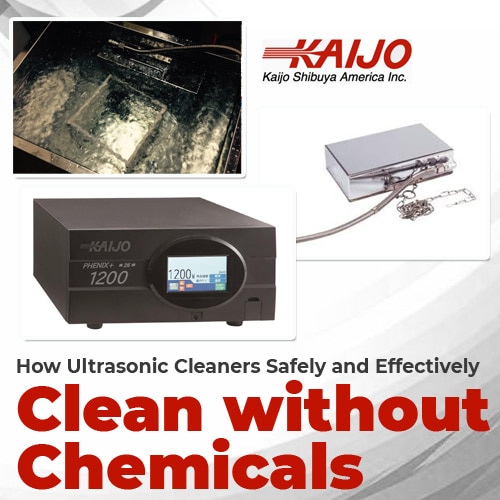How Ultrasonic Cleaners Safely and Effectively Clean Without Chemicals
October 21, 2020
 Traditional cleaning of industrial parts, mechanical components and electronics has typically involved soaking in aggressive chemicals, pressure washing and manual scrubbing. These methods can damage the surfaces of the parts to be cleaned, use large quantities of water, are costly and are time-consuming. While some parts can be cleaned adequately in this way, parts with dead-end openings, threaded holes or complex shapes often retain contamination in hard-to-reach places.
Traditional cleaning of industrial parts, mechanical components and electronics has typically involved soaking in aggressive chemicals, pressure washing and manual scrubbing. These methods can damage the surfaces of the parts to be cleaned, use large quantities of water, are costly and are time-consuming. While some parts can be cleaned adequately in this way, parts with dead-end openings, threaded holes or complex shapes often retain contamination in hard-to-reach places.
Ultrasonic cleaners work without harsh chemicals while cleaning parts quickly and completely. Eliminating chemicals and reducing the use of water saves money and results in a safer work place. The use of industrial ultrasonic cleaners with the right frequency and power represents an effective alternative to traditional cleaning methods.
How the Mechanical Cleaning Action of Ultrasonic Cleaners Delivers Superior Cleaning Performance
Ultrasonic cleaners work by generating millions of microscopic bubbles in the cleaning solution. An ultrasonic generator produces a high-frequency electric signal for an ultrasonic transducer. The transducer is immersed in the cleaning bath and vibrates in tune with the electric signal. The transducer vibrations produce ultrasonic sound waves throughout the cleaning solution.
Ultrasonic sound waves have high-pressure peaks and low-pressure troughs. The microscopic cavitation bubbles form in the low-pressure troughs and collapse in the high-pressure peaks. When the bubbles collapse, they emit a tiny high-pressure jet that hits the surface of the parts to be cleaned and dislodges dirt and contaminants. These jets deliver a powerful mechanical cleaning action that works faster and better than cleaning with chemicals.
While cleaning more thoroughly than traditional methods, ultrasonic cleaners can be fine tuned for the specific cleaning application. An experienced ultrasonic cleaner manufacturer can determine which frequencies produce the best results. With the lowest frequencies, around 20 to 30 kHz, bubbles are comparatively large and the tiny jets are very powerful. These frequencies are best suited for rugged parts with hard surfaces. As the frequency increases, the bubbles become smaller and the jets less powerful. The higher frequencies can be matched to parts that are fragile or have soft surfaces, with the highest frequencies of several hundred kHz suitable for the most delicate parts.
Once the right frequency is selected, the ultrasonic sound waves penetrate everywhere throughout the cleaning solution. The jets from the collapsing bubbles clean inside holes, along cracks and over rough surfaces. Dirt and contaminants are removed completely everywhere. No manual scrubbing to clean up residue is required.
Ultrasonic Cleaners Save Money in Five Main Ways
The use of ultrasonic cleaners to replace traditional cleaning methods can result in improved cleaning performance and increased safety for operators. Beyond these general advantages, ultrasonic cleaning delivers specific savings, including the following:
- No costs for chemical purchase, storage or disposal.
- No manual cleaning reduces labor costs.
- Increased throughput due to faster cleaning.
- Lower failure rates due to reduced part damage.
- Reduced costs for environmental compliance.
Changing from traditional cleaning methods to the use of industrial ultrasonic cleaning equipment can reduce the overall costs of production while delivering improved production outcomes. In the absence of toxic chemicals in their workplace, operators can dispense with protective gear and restrictive safety policies. For ultrasonic cleaners, they simply set a timer and leave to carry out other work. When they return, they can remove the completely clean parts from the cleaning bath.
Kaijo Offers Ultrasonic Cleaning Consulting and Manufactures the Ultrasonic Equipment
Kaijo has extensive experience with industrial ultrasonic cleaning equipment and has developed unparalleled expertise by carrying out all design and manufacturing in house. The company works closely with manufacturers in many different industries to develop and deliver equipment that meets their needs. Kaijo can help select the ultrasonic cleaning system a customer needs and can deliver both standard and custom solutions.





